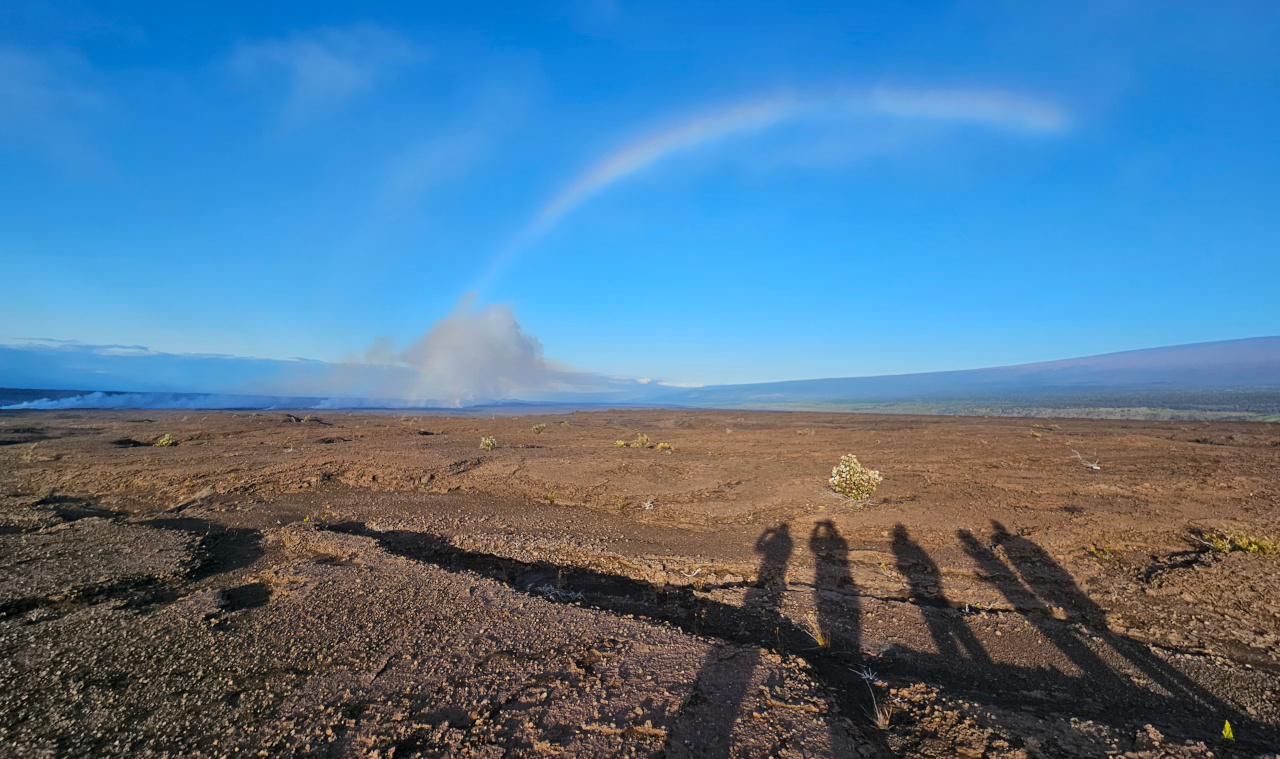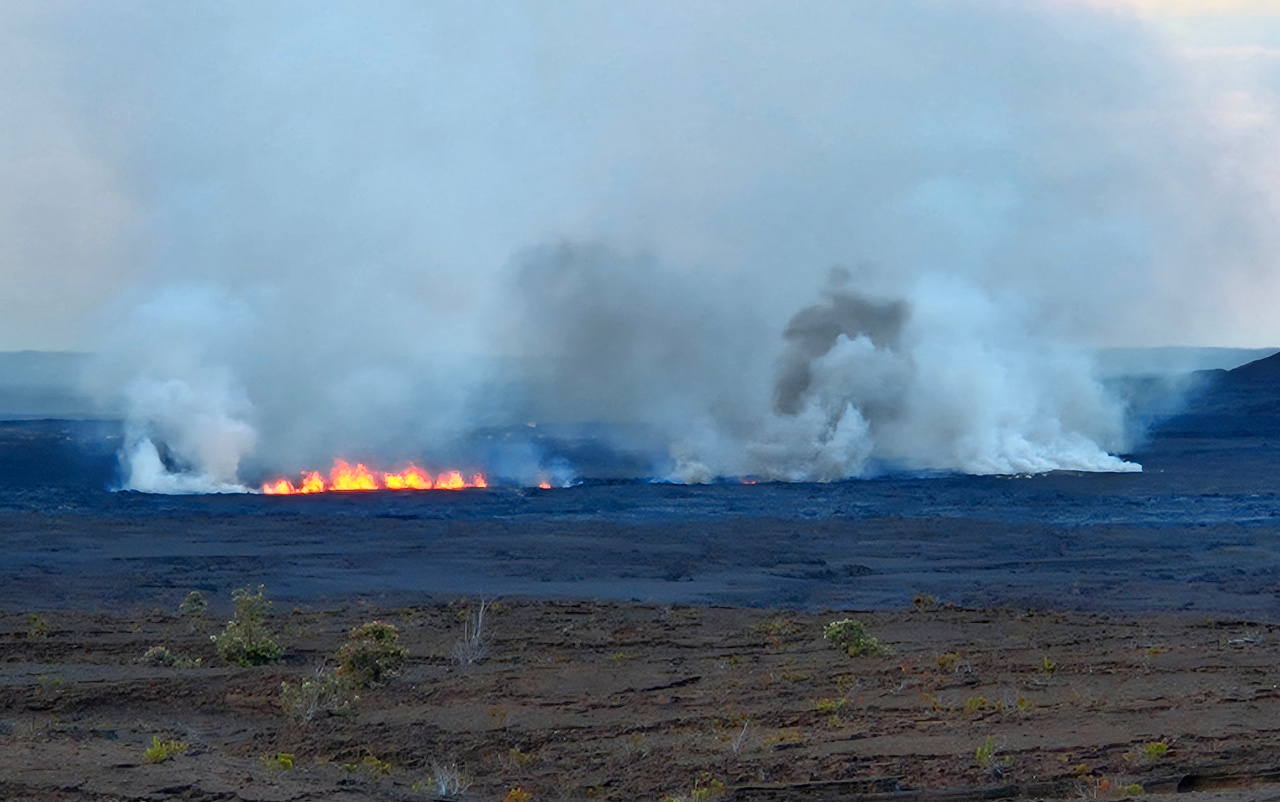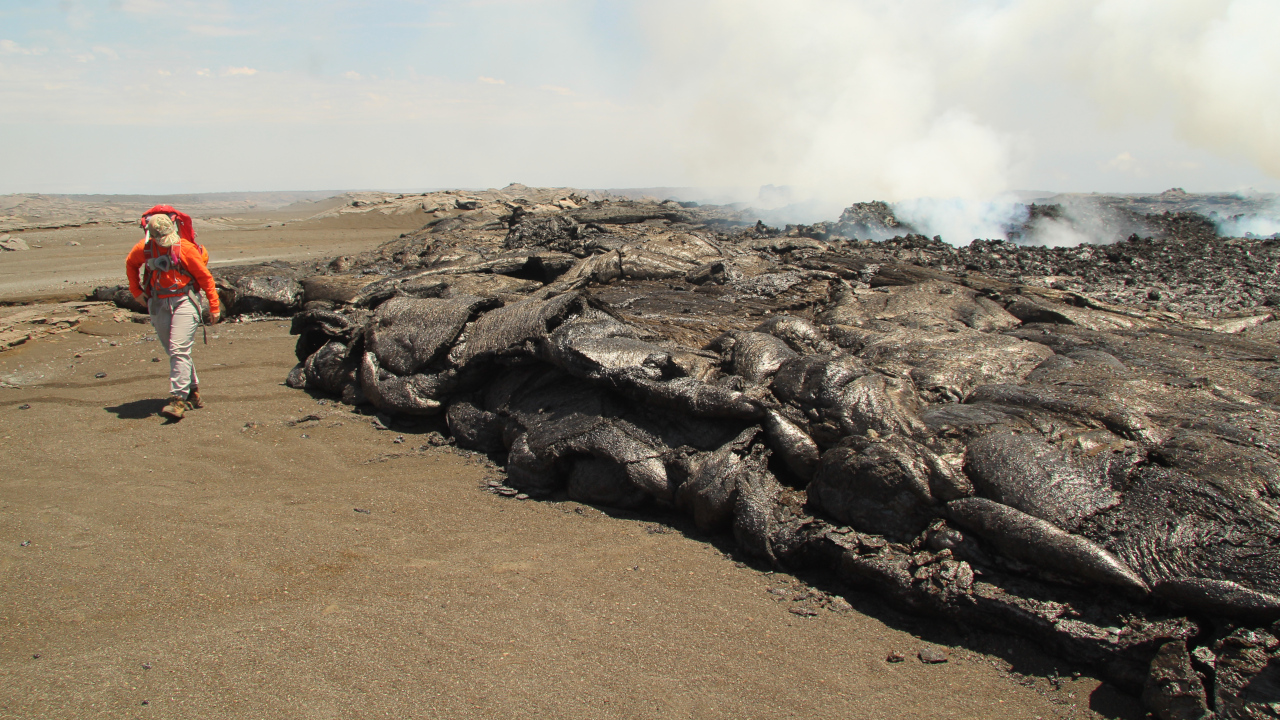(BIVN) – The new eruption of Kīlauea volcano in the upper Southwest Rift Zone remains paused, and scientists say it is unlikely to restart.
On Wednesday, the USGS Hawaiian Volcano Observatory lowered the Volcano Alert Level from WATCH to ADVISORY and the Aviation Color Code from ORANGE to YELLOW, after tremor, degassing, and incandescence associated with the new fissure vents decreased substantially over the past 48 hours.
Volcanic gas emissions at the eruption site remain well above background levels, scientists say. Overall seismicity in the summit region, including the eruption area, remains low. Rates of inflationary ground deformation in the summit region increased over the past day, the USGS HVO says.
Closures within Hawaiʻi Volcanoes National Park remain in place. The Kaʻū Desert area is closed due to volcanic gas hazards including Hilina Pali Road, Kulanaokuaiki Campground, Pepeiao Cabin and Maunaiki Trail.
From the USGS HVO update written at 12:03 p.m. HST:
Eruption Site Observations: Lava stopped erupting from the fissure vents at approximately 9:00 a.m. HST on June 3 and lava flows stagnated by noon that day. Lava from the fissure system covered approximately 90 acres (350,000 square meters), a relatively small area. Glow was observed in webcam imagery overnight at the site of the fissures. Volcanic gas emissions at the eruption site remain well above background levels (100 tonnes per day or less), with a sulfur dioxide emission rate of 5,500 tonnes per day (t/d) measured yesterday, June 4, down from 12,000-15,000 t/d on June 3. The lack of trade wind conditions this morning may increase the potential for higher vog concentrations around the summit of Kīlauea.
Numerous large ground cracks have formed in the vicinity of the eruption extending westward to within 540 yards (500 meters) of Maunaiki. Earthquake activity remains low in the eruption site area.

USGS: “While observing the new fissure eruption in Kīlauea’s Southwest Rift Zone, HVO scientists in the field were treated to views of rainbow terminating in the cloud of volcanic gases.” (USGS photo by Tricia Nadeau/HVO)
Summit and Upper Rift Zone Observations: Rates of seismicity beneath the summit, upper East Rift Zone, and upper Southwest Rift Zone remained low over the past day. Tremor related to the eruptive vents continues to decrease across the summit region. Less than 30 earthquakes have occurred over the past 24 hours. Earthquakes were located beneath the south caldera and the upper East Rift Zone, at depths of 1.5-3 km (1–1.8 miles), with magnitudes under M2.0. Ground deformation beneath Halemaʻumaʻu and the south caldera region transitioned to inflation over the past 24 hours. The Uēkahuna tiltmeter northwest of the summit recorded a deflationary signal yesterday morning that transitioned to inflation around noon yesterday, with approximately 3 microradians of inflation since then. The Sand Hill tiltmeter southwest of the summit recorded approximately 6 microradians of inflation since 4:00 p.m. yesterday.
Lower Rift Zone Observations: Rates of seismicity and ground deformation beneath the middle and lower East Rift Zone and lower Southwest Rift Zone are low. Eruptive activity and unrest is restricted to the summit and upper rift zone regions. Measurements from continuous gas monitoring stations downwind of Puʻuʻōʻō in the middle East Rift Zone remain below detection limits for SO2, indicating that SO2 emissions from Puʻuʻōʻō are negligible.
Eruption Summary: Emplacement of a magmatic dike began just after 12:00 p.m. HST on June 2, 2024, beneath the area of Kaluapele south of Halemaʻumaʻu. Seismicity continued to intensify beneath this area and HVO raised the alert levels from Advisory/Yellow to Watch/Orange as the dike shallowed. Around 8:00 p.m. on June 2 a strong deflation signal on the Sand Hill tiltmeter indicated that a significant mass of lava moved to another location despite a lack of seismicity. After the deflationary event, seismicity declined significantly, and it was no longer possible to track the underground location of the magma. Data from USGS webcams and Keck Observatory webcams determined that the eruption began at 12:30 a.m. June 3, and effusion at the vents remained active until approximately 9:00 a.m., though lava flows were moving sluggishly until about noon. The pasty surface textures of the erupted lava and the small amount of lava erupted suggests that this was lava first emplaced during the January 31, 2024, event and cooled prior to being forced to the surface by the new dike.

USGS: “In this photo taken at about 6 a.m. HST on June 3, both lava fountains (left) and emissions of volcanic ash (right) are visible erupting from the new fissures in Kīlauea’s Southwest Rift Zone. The ash is dark gray, while the remainder of the whitish plumes are composed of steam and other volcanic gases.” (USGS photo by Tricia Nadeau/HVO)
Analysis: The last recorded eruption in this area occurred in December 1974, which lasted 6 hours and eruption 13 million cubic yards (10 million cubic meters) of lava. The 1974 eruption covered about 3 square miles (7 square kilometers). In contrast, the recent eruption spanned 8.5 hours but only erupted about 1% of the volume and covered about one third of a square mile (one half of a square kilometer).
Tremor, degassing, and incandescence associated with the fissure vents have decreased substantially over the past 48 hours, making it unlikely that the eruption will resume. However, additional pulses of seismicity and deformation could result in new eruptive episodes within the area or elsewhere on the Southwest Rift Zone. HVO lowered the Volcano Alert Level for ground-based hazards from WATCH to ADVISORY and the Aviation Color Code from ORANGE to YELLOW on June 5 at 10:07 a.m. HST.


by Big Island Video News4:54 pm
on at
STORY SUMMARY
HAWAIʻI VOLCANOES NATIONAL PARK - The eruption is unlikely to resume as tremor, degassing, and incandescence from the fissure vents in the Southwest Rift Zone have decreased over the past 48 hours.